Menus
- Superbikes in the comparison test
- Quickshifter of the Kawasaki Ninja ZX-10R slips clean
- Test, test and eat up seconds
- Low speeds? Not a thing that BMW marches
- BMW burns the fastest time in the asphalt
- How is the new Kawasaki Ninja ZX-10R doing?
- The Kawa snorts furiously at the hard braking point
- The Kawa doesn’t do much under 8000 tours
- Yamaha YZF-R1M a real racing motorcycle
- At the end of the test we are a little at a loss as to the outcome
- Technical specifications
- Rating racetrack
- Result and conclusion
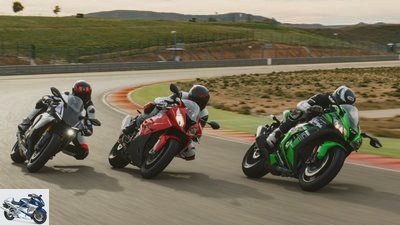
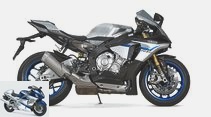
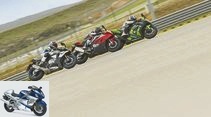
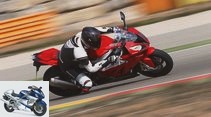
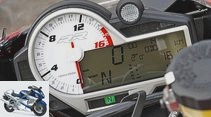
22nd photos
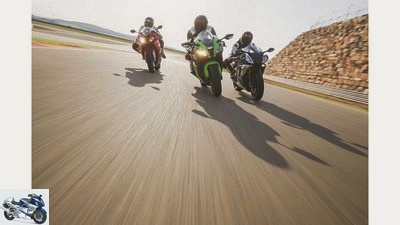
1/22
BMW S 1000 RR, Kawasaki Ninja ZX-10R and Yamaha YZF-R1M.
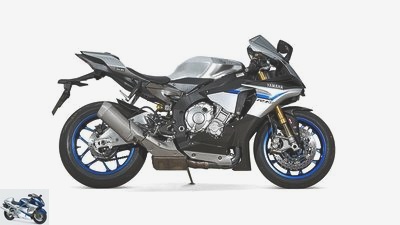
2/22
Yamaha YZF-R1M.
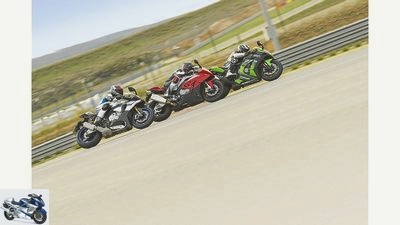
3/22
BMW S 1000 RR, Kawasaki Ninja ZX-10R and Yamaha YZF-R1M.
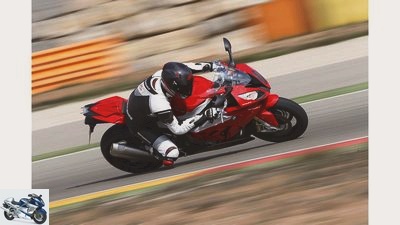
4/22
BMW S 1000 RR.
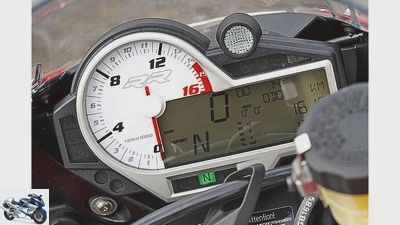
5/22
Good mix of analog and digital display on the BMW S 1000 RR.
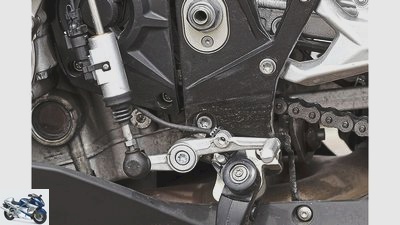
6/22
The S 1000 RR automatic gearshift often refused to work, the blipper function did not work at all.
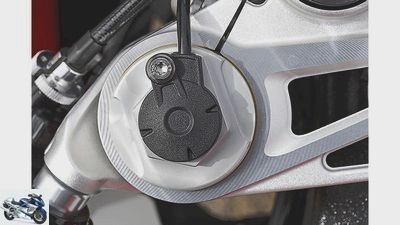
7/22
As usual, the test motorcycle from Munich also had a semi-active chassis.
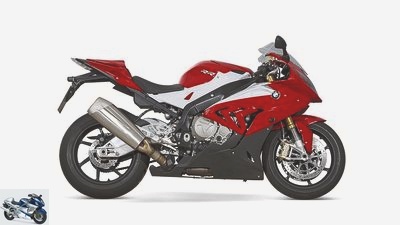
8/22
BMW S 1000 RR.
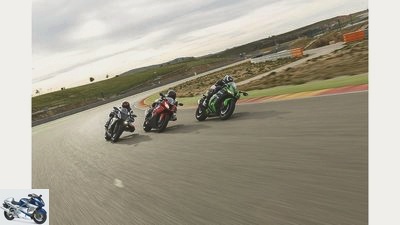
9/22
In the end, the Yamaha YZF-R1M snatched victory in the Superbike group test.
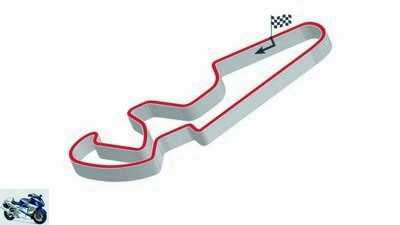
10/22
This time we moved to the World Championship track in Aragon. Unfortunately, the Spanish weather at the beginning of March was not exactly from its pleasant side and tormented us on the first day of the test with icy temperatures.
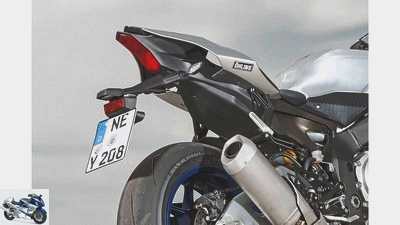
11/22
Nice to look at Yamaha rear, which however begins to prance during hard braking maneuvers.
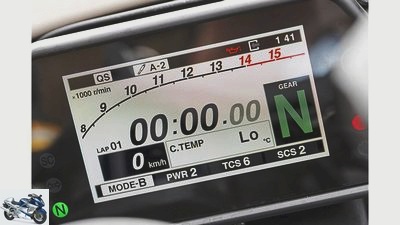
12/22
Perfectly readable display in the cockpit of the Yamaha with many options.
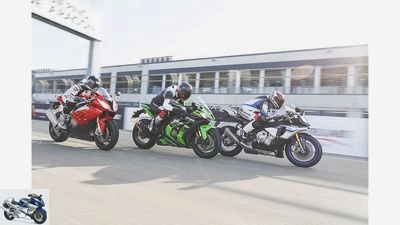
13/22
Kawasaki’s new ZX-10R dominates the Superbike World Championship. Does it have what it takes to leave the competition behind??
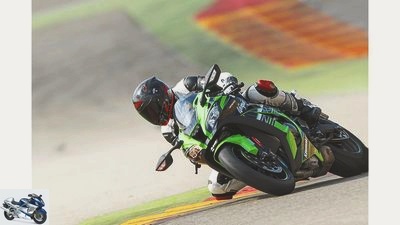
14/22
Kawasaki Ninja ZX-10R.
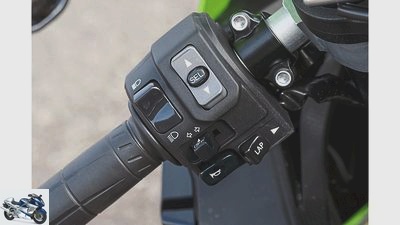
15/22
The traction control can now be easily controlled from the right handlebar stub.
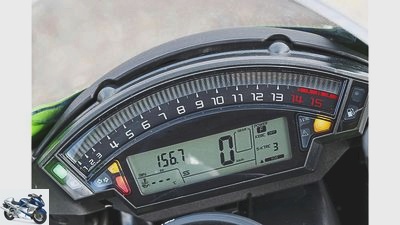
16/22
The readability of the small cockpit display suffers at high speeds.
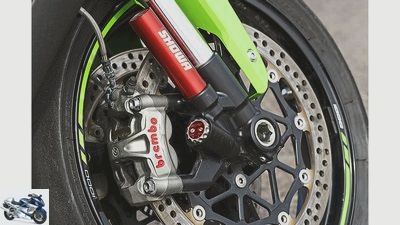
17/22
Great fork with clean response and setup, questionable braking performance.
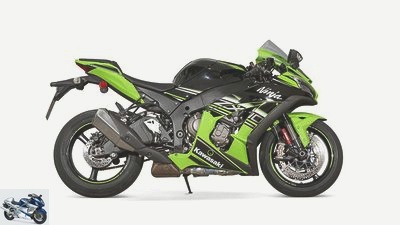
18/22
Kawasaki Ninja ZX-10R.
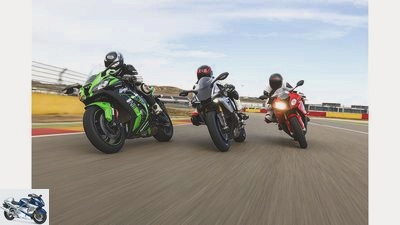
19/22
The next morning, the flags at the racetrack hung almost limp, and the sun warmed the track by noon in the double-digit range.
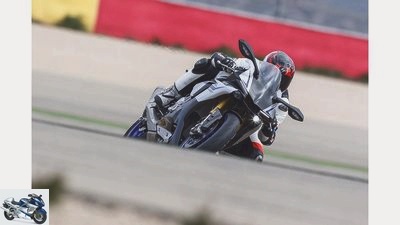
20/22
Yamaha YZF-R1M.
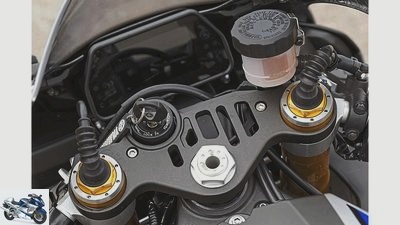
21/22
The semi-active counterpart of the R1M is significantly more suitable for the race track than the chassis of the R1.

22/22
Elsewhere, the new Kawasaki superbike is definitely ahead of the two competitors. Kawasaki Ninja ZX-10R has Euro 4 homologation. One can imagine that it will be more difficult to achieve fat propulsion in all positions with it.
BMW S 1000 RR, Kawasaki ZX-10R and Yamaha YZF-R1M
Superbikes in the comparison test
Content of
The Kawasaki Ninja ZX-10R dominates the Superbike World Championship. So does it have what it takes to leave the two in-line four-cylinder superbikes BMW S 1000 RR and Yamaha YZF-R1M behind in the comparison test – according to the motto "From the box to the slopes"?
Who will win this time – Rea or Sykes? That is the most important question before almost every World Superbike race. The Kawasaki Ninja ZX-10R is so dominant, all victories from the first four races in 2016 went to the Kawasaki team with world champions Jonathan Rea and Tom Sykes. And a lot of experience of this nimble duo has flowed into the new series 10 series. So a killer for everyone – who dominates the World Cup, also dominates the series super athletes? To check that, we moved to the Aragon World Championship track and took the in-line four-cylinder competition with us: The Yamaha YZF-R1 in the more aggressive M version and the BMW S 1000 RR, which has so far been so dominant in this segment.
Buy complete article
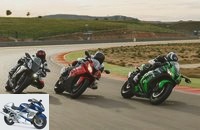
BMW S 1000 RR, Kawasaki ZX-10R and Yamaha YZF-R1M
Superbikes in the comparison test
Shift problems on the BMW S 1000 RR
Nevertheless, it was enough for initial insights, which led to discussions in the closing meeting of that day. The BMW S 1000 RR had a massive problem with the standard gearshift, refused sixth gear completely and, strangely enough, already the fourth at the start / finish. The blipper function, i.e. downshifting without the clutch, didn’t work at all. A phenomenon that the BMW community reported in various forums, but that appeared for the first time with our test machines.
In return, the brake was extremely stable, which we hadn’t seen before and therefore criticized the shifting pressure point in the last tests with the Bayern-Wumme. The Yamaha YZF-R1M also shone with its crisp, transparent brakes, but danced with the rear in hard anchor situations, but with its engine characteristics it fitted very nicely to Aragon and provided a cleanly switchable quickshifter.
Quickshifter of the Kawasaki Ninja ZX-10R slips clean
And the Kawasaki Ninja ZX-10R? At first there wasn’t much that could be said about handling the stormy gusts. Your quickshifter slipped clean, but the brakes amazed us. At the presentation in Sepang, it was still as stable as a real racing iron in the scorching heat, now looked extremely dull, undefined and simply couldn’t be used appropriately.
There were also indications that the Kawasaki Ninja ZX-10R would have real problems below 8000 rpm, because in Aragon there is not just one corner where the green one has to go through first gear and the speeds of the four-cylinder engine drop in the basement . But after all, we are testers and not speculators, which is why we only let it go at that moment and before going to bed we all made a sacrifice to the weather gods – with success. The next morning, the flags at the racetrack hung almost limp, and the sun warmed the track by noon in the double-digit range.
Test, test and eat up seconds
Our test procedure now stipulated that we should drive one turn each in the order BMW S 1000 RR, Kawasaki Ninja ZX-10R and Yamaha YZF-R1M, then collect our impressions and finally deepen or revise them in three further turns. After that, all three combatants will be driven for time – the fastest was Sergio Romero. Our Spanish colleague with home game advantage therefore sets the lap time.
The BMW S 1000 RR generally left the impression that the combination of this engine, which actually always goes full tube, and the rock solid handling gave every driver a package – regardless of ability – with which he can get fast laps after a short time to get used to it. In fact, the S 1000 RR doesn’t really serve an “ahhh” experience, this amazement, grin and inner jubilee about something that touches your racer’s heart. Riding the S 1000 RR means unspectacular balance on the slopes – but it makes you damn fast.
Low speeds? Not a thing that BMW marches
It starts after the first few meters in the saddle: The motorcycle looks long, you sit in the BMW S 1000 RR, almost a little too relaxed for a superbike. But: a twist of the throttle, and the Bayern four pushes vehemently. Low speeds? Not a thing that BMW marches. Medium speeds? Yep, march. Five-digit range? Holla the forest fairy! The engine runs a bit rough, but that doesn’t really matter. The gas takes the double R like none of the Japanese women very nicely and fires – we like to repeat ourselves there – immediately.
After we had calmed the pumping rear by changing the chassis, a very similar picture emerged in terms of handling. The BMW S 1000 RR took tight corners without any great resistance, it was quite decent in fast passages in an inclined position, without, however, achieving the stability of the Yamaha YZF-R1M and certainly not the Kawasaki Ninja ZX-10R, and it was also easy to negotiate in a bit of changing corners throw accurately from one side to the other. By no means sluggish, if not exactly bombastic. That certainly has to do with the fact that the BMW driver has to show more commitment in order to be able to quickly fold the bike, which has a low center of gravity, from one side to the other. In general, however, BMW’s talent is also evident when it comes to driving behavior: unspectacular, calm, but professional and fast.
jkuenstle.de
Kawasaki’s new ZX-10R dominates the Superbike World Championship. So here too she has what it takes to leave the competition behind?
The electronics of the BMW S 1000 RR are known to work very well. In order to take the whole 1000 power from the tight corners to the sprint sections, we find the perfect TC setting for our tires at level -4 in slick mode, with which we can fearlessly tear open the gas without the departure preventer slowing down the propulsion too roughly . Only the control intervals could be a bit smoother, as we were able to experience with the competition.
The fact that there is still a “wow cool” for the BMW turns is due to the brakes. It has the perfect mix of initial bite and finely adjustable progression. The pressure point remained stable – until we drove the temperature of the system up again in the afternoon for the final lap time bolt. The brake gave a tick, but then held out. As the only brake in the test field, the ABS on the BMW S 1000 RR could be switched off in slick mode at the push of a button. But the Bavarian also braked extremely sportily with ABS.
BMW burns the fastest time in the asphalt
Only the automatic gearshift was completely off the mark. That he partially failed the service was one thing. However, the fact that the transmission was difficult to shift even with the use of the clutch set the BMW S 1000 RR far behind the competition in this area. We also tried several times to set the shift light as we feared that its early flashing at just over 4000 rpm could be related to the difficulty in changing gear. But we did not succeed.
The fact that, despite this operating disadvantage, the BMW burned the absolutely fastest time in the asphalt of the Aragon GP circuit and all testers were very fast, speaks for the overall package of the BMW S 1000 RR. In summary, even in the sixth year of its existence and before its Euro 4 homologation for the 2017 model year, the BMW is a brutal burner that primarily benefits from its engine power and otherwise just does everything very, very well.
How is the new Kawasaki Ninja ZX-10R doing?
Tension! Can the Kawasaki Ninja ZX-10R now set accents where the BMW S 1000 RR does so unspectacularly? In any case, at the very beginning it can be stated that the Kawasaki competes with the other two superbikes with a clearly renovated, but still “conventional” chassis.
The changes to the chassis of the Kawasaki Ninja ZX-10R ensure a good feeling when sitting on. The steering head has finally moved closer to the driver at the behest of the World Championship racers. This is much more active for those who like racing. However, the Kawa chassis is still more towards the BMW S 1000 RR than towards the uncompromising racing geometry of the Yamaha YZF-R1M.
The Kawasaki Ninja ZX-10R basically puts the front wheel in the hand of its pilot.
The highlight on the racetrack is clearly the cornering stability of the Kawasaki Ninja ZX-10R, especially when it comes to turning corners at high speed. No other series iron takes the long left before the start / finish or the one after the “corkscrew” as confidently as the Kawasaki. That is certainly due to the chassis, but the electronics also have their part in it. The Kawasaki is similarly stable in the braking zones. The fork successfully braces itself against the weight and the hindquarters stubbornly sticks to the asphalt. Everything is still in order, as we shall see shortly.
Everything is okay with the feeling for the front too. Perhaps this is the biggest step forward compared to its predecessor. The Kawasaki Ninja ZX-10R basically puts the front wheel in the hand of its pilot. That was how you wanted it to be with the BMW S 1000 RR. The fine response and the smooth damping of the Showa fork are just great. Only the Yamaha YZF-R1M does better in this test field.
The Kawa snorts furiously at the hard braking point
In contrast, the Kawasaki Ninja ZX-10R does not show anything when it comes to the control behavior of the TC. The disaster preventers do their job so subtly that one may doubt their existence from time to time. But how well the Kawa can be bolted on a badly damaged K1 racing tire along the drift and take-off limit, especially in the ultra-fast links of our section 2, is phenomenal and underlines how good the combination of ECU calculations and IMU Data acquisition works. You never have the feeling of being slowed down – on the contrary.
The Kawasaki Ninja ZX-10R snorts furiously at the hard braking point. But right now the test Kawasaki is losing time. At such corner entrances – and also in narrow passages at the corner exit. One problem was the somewhat slower handling when turning in and pulling into the tight line. Somehow the 10 series didn’t want to be as easy as their competition.
Can the new Ninja prevail against the previously so successful BMW S 1000 RR?
Unfortunately, in the end we didn’t have the time to counter this phenomenon with deeper chassis interventions, for example by raising the rear. With the ingenious new chassis of the Kawasaki Ninja ZX-10R, there would certainly have been more, even if the pressure level of 1.5 revs out of five possible at these cool temperatures suggests a relatively narrow radius of action. At almost 40 degrees during the presentation in Malaysia, the monoshock pressure level was on one revolution! But if it only takes so little – respect!
Much more worries at the entrance to the curve were the brakes instead of a bit more unruly handling. Hitting the right cornering speed towards the apex was often a matter of luck because the stoppers offered zero progression. Once pulled and decelerated, the pilot could pull the lever as vehemently, but there wasn’t much more braking effect. Since the ABS cannot be switched off and we were allowed to brake without it in Sepang, we suspect that the brake pressure modulator of the anti-lock device could do the Kawasaki Ninja ZX-10R a disservice here. The brake pads were neither glassy nor beyond the wear limit. There is a dongle in the race kit with which the ABS can be switched off. We have already ordered one and want to get to the bottom of this phenomenon in the next PS, because more has to be done with the new, expensive M50 calipers from Brembo.
The Kawa doesn’t do much under 8000 tours
Unfortunately, not much is possible in the Euro 4 homologated ZX-10R under 8000 tours. The 10 is so difficult to get out of the quark that you even want to push it in such sections. Where the BMW S 1000 RR sometimes ironed out in second gear, the Kawasaki Ninja ZX-10R leaves its pilot no choice but to try for the A (which is not a problem with the fluffy gearbox itself) – and even then it lays down felt like a moment of memory. That adds up on a route like in Aragon, when you can see from the recording that you have to accelerate again from under 80 km / h eight times. Real racers among the Kawasaki fans should be said to be consolation that the open 10er (without Euro 4) removes the lack of clogged power from the speed basement by converting it to the kit bike. You still have to live with the long basic gear ratio of the first gear, but it works quite well as a racing bike.
Nevertheless, there is good news for all friends in green about the Kawa quadruplet. No other engine in the test field runs as smoothly and as quickly as this one. And he always delivers enough pressure for hard fights with the other two beyond the 10,000 barrier. With the grown swing arm, the Kawasaki Ninja ZX-10R delivers fat traction – and that often counts more than the last bit of handiness.
Yamaha YZF-R1M a real racing motorcycle
Up on the Yamaha YZF-R1M! You instantly feel on board a real racing motorcycle. The whole thing looks compact, the driver sits high and very actively above the handlebars. This impression continued on the route. With the Metzeler Racetec, no other test bike served such an inspiring handiness and precision as the Yamaha. Line thought – made with the R1. With the high center of gravity and the shortest wheelbase in the test field, the R1M was eager to change direction. The only downer was the partially wedged rear end with hard braking attacks, although this is noticeably weaker in the M version with semi-active chassis than in the “normal” R1 with conventional damping.
The forehand compensates for this. This is racing out of the box when the R1 can be driven deeply over the front wheel. As with the Kawasaki Ninja ZX-10R, a deactivatable ABS on the Yamaha YZF-R1M would not be bad, albeit for completely different reasons. The system basically brakes at the rear. Depending on the situation, this is counterproductive because the feeling for the hindquarters is more likely to be lost. As an attacker on the race, you want more autonomy over your own world of experience. Overall, however, the brake was the best in the field: precisely adjustable, bomb-proof, wonderfully progressive, with a fat initial bite.
When upshifting, the automatic gearshift of the Yamaha YZF-R1M was inconspicuous in every situation.
The wonderfully independent engine with its V4 characteristics continued to support the enthusiasm for the Yamaha YZF-R1M, even if it did not reach the punch of the BMW S 1000 RR at medium speeds. Perhaps the crank pin misalignment during the attack is faking more than it actually is. Fast, and the lap times show that, the four in a row is always fast.
The gear ratio matched the track very well. Although you had to try first gear here and there, the transmission left nothing to be desired, thanks to the appropriate engine brake electronics and anti-hopping clutch, you could simply let go of the clutch lever when downshifting to the lowest gear without hesitation. When upshifting, the automatic gearshift of the Yamaha YZF-R1M was inconspicuous in every situation.
At the end of the test we are a little at a loss as to the outcome
Unfortunately, the Yamaha YZF-R1M continues to accelerate in the relevant mappings, which reduces driving pleasure and costs points. On the whole, however, the Yamaha showed that it was clearly built for the racetrack, at least in the M version. And now? At the end of the test we are a little at a loss as to the outcome. Is the difference between a World Championship winning motorcycle and a production superbike as striking as our result suggests?
Clearly no. Not in this case, because the Kawasaki lost its race with us mainly due to a brake that puzzles us and which absolutely needs to be checked. Elsewhere, the new Kawasaki superbike is definitely ahead of the two competitors. The Kawasaki Ninja ZX-10R has Euro 4 homologation. One can imagine that it will be more difficult to achieve fat propulsion in all positions with it. It remains to be seen whether the BMW S 1000 RR and the Yamaha will do better next year. The fact is, however: the production BMW S 1000 RR is damn fast and still the most balanced and user-friendly package among the superbikes. And the Yamaha YZF-R1M is the most radical 1000 among the inline four-cylinder engines when it comes to performance on the slopes out of the box.
Technical specifications
Can the brand new Kawasaki Ninja ZX-10R hold its own against the competition?
Here you can see an extract of the technical data. If you would like the complete measurement values determined by us, including all consumption, torque and acceleration values, you can buy the article as a PDF for download.
Rating racetrack
Which superbike earns the most points??
| Max. Points | BMW S 1000 RR | Kawasaki Ninja ZX-10R | Yamaha YZF-R1M | |
| drive | ||||
| Power delivery | 10 | 10 | 7th | 9 |
| Responsiveness | 10 | 9 | 7th | 8th |
| Load change reaction | 10 | 9 | 8th | 7th |
| Running culture | 10 | 7th | 9 | 8th |
| Gear actuation | 10 | 5 | 9 | 9 |
| Gear ratio | 10 | 9 | 7th | 9 |
| Clutch function | 10 | 9 | 9 | 9 |
| Traction control | 10 | 9 | 9 | 9 |
| Subtotal | 80 | 67 | 65 | 68 |
| landing gear | ||||
| Driving stability | 10 | 8th | 9 | 7th |
| Handiness | 10 | 8th | 7th | 9 |
| Cornering stability | 10 | 7th | 9 | 8th |
| Steering precision | 10 | 7th | 9 | 10 |
| feedback | 10 | 8th | 9 | 9 |
| Suspension tuning in front | 10 | 8th | 9 | 10 |
| Chassis set-up at the rear | 10 | 8th | 9 | 9 |
| Braking effect | 10 | 9 | 7th | 9 |
| Brake metering | 10 | 9 | 5 | 9 |
| ABS function | 10 | 9 | 7th | 9 |
| Sitting position | 10 | 8th | 9 | 10 |
| Lean angle | 10 | 10 | 10 | 10 |
| Subtotal | 120 | 99 | 99 | 109 |
| Lap time | ||||
| Lap time * | 20th | 20th | 11 | 18th |
| Total | 220 | 186 | 175 | 195 |
| placement | 2. | 3. | 1. |
* Points key: Best time: 20 points. Delay up to 0.2 s: 19 points; 0.21 s to 0.4 s: 18 points; 0.41 s to 0.6 s: 17 points; 0.61 s to 0.8 s: 16 points; 0.81 s to 1.0 s: 15 points; 1.01 s to 1.2 s: 14 points; 1.21 s to 1.4 s: 13 points; 1.41 s to 1.6 s: 12 points; 1.61 s to 1.8 s: 11 points; 1.81 s to 2.0 s: 10 points; 2.01 s to 2.2 s: 9 points; 2.21 s to 2.4 s: 8 points; 2.41 s to 2.6 s: 7 points; 2.61 s to 2.8 s: 6 points; 2.81 s to 3.0 s: 5 points; 3.01 s to 3.2 s: 4 points; 3.21 s to 3.4 s: 3 points; Etc.
Result and conclusion
In the end, the Yamaha YZR-R1M won the Superbike group test with ease.
1st place – Yamaha YZF-R1M:
With the M package, the Yamaha YZF-R1 deserves to win this PS Superbike test. Its powerful engine, the sophisticated electronics and the superb, racetrack-oriented driving behavior, especially with the semi-active chassis, inspire.
2nd place – BMW S 1000 RR:
The engine of the BMW S 1000 RR is still the ultimate among the superbikes for sale. The fact that it was not enough to win the test this time is mainly due to the deductions on the gearbox for the poorly functioning automatic gearshift and the somewhat inferior handling compared to the Yamaha YZF-R1M.
3rd place – Kawasaki Ninja ZX-10R:
After the presentation in Sepang, we went into the test with great expectations with the 10 series. However, the performance really ruined the brake and the lack of power below 8000 rpm. The point deduction based on the lap time is therefore huge. Otherwise, the Kawasaki Ninja ZX-10R has a lot of potential. We go into the matter.
Related articles
-
Comparison test: Honda CB 1000 R, Yamaha FZ1, Triumph Speed Triple, Kawasaki Z 1000
Comparison test: Honda CB 1000 R, Yamaha FZ1, Triumph Speed Triple, Kawasaki Z 1000 Large naked bikes in comparison Contents of …
-
Comparison test Harley-Davidson Fat Boy, Kawasaki 1500 VN, Yamaha XVZ 1300 A
Comparison test, Harley-Davidson Fat Boy, Kawasaki VN 1500 Classic, Yamaha XVZ 1300 A Royal Star Harley-Davidson Fat Boy, Kawasaki 1500 VN, Yamaha XVZ …
-
PS Bridgestone Tuner GP 2016 – 1000 Superbikes in comparison test
fact 27 photos markus-jahn.com 1/27 Picture gallery, TunerGP: 1000 Superbikes in comparison. markus-jahn.com 2/27 Bartschat-Kawasaki ZX-10R. Lap time:…
-
fact Concept comparison Honda CBR 1100 XX Kawasaki ZX-12 R Suzuki GSX-R 1000 Suzuki GSX 1400 Yamaha FZS 1000 Fazer Yamaha FJR 1300 Six bombs The six most…
-
BMW, Honda, Kawasaki, Suzuki and Yamaha super sports cars in a comparison test
Judd 26th photos Nicolaou 1/26 In the supersports comparison test: Kawasaki ZX-10R, BMW S 1000 RR, Suzuki GSX-R 1000, Honda Fireblade C-ABS and Yamaha…
-
Comparison test Suzuki SV 650, Honda CB 650 F, Kawasaki ER-6n, Yamaha MT-07
www.bilski-fotografie.de 34 pictures www.bilski-fotografie.de 1/34 They are the hottest candidates among the middle class naked bikes ….
-
Comparison test sports tourer Kawasaki Z 1000 SX Tourer, Triumph Sprint GT
www. 35 pictures www. 1/35 Sports tourers sit between all chairs, but the temptation lies in this niche: there are bikes, …
-
Comparison test Kawasaki GTR 1000, Triumph Trophy 1200, Yamaha FJR 1300
fact comparison test Kawasaki GTR 1000, Triumph Trophy 1200, Yamaha FJR 1300 As time goes by In honor grayed out ?? and still to have: two veteran …
-
Comparison test Honda CBR 500 R, Kawasaki Ninja 400, KTM RC 390, Yamaha YZF-R3
r-photography.info 29 pictures r-photography.info 1/29 Honda CBR 500 R, Kawasaki Ninja 400, KTM RC 390 and Yamaha YZF-R3 in comparison test ….
-
Honda CB 1000 R, Kawasaki Z 1000 SE, Yamaha FZ1 in the test
www. 48 photos www. 1/48 On the MOTORRAD test tracks in southern France, Honda’s CB 1000 R and Yamaha’s FZ1 are ready to test…